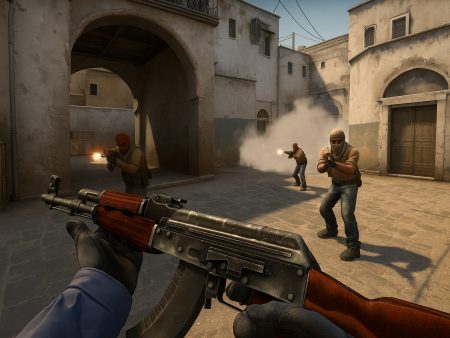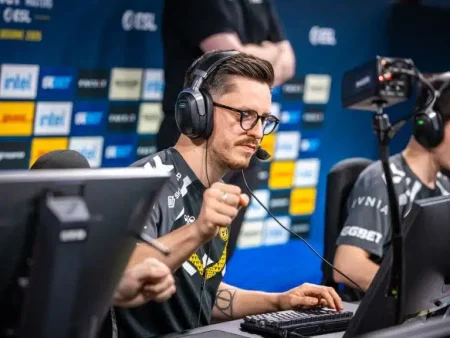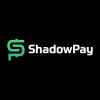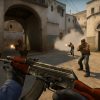Master every crucial smoke and grenade lineup on Nuke in CS2/CS:GO with this complete guide. Learn pro-level strategies, lineups, and tips to dominate both A and B sites with expert utility usage.
Nuke is one of the most complex and strategic maps in Counter-Strike, especially in CS2/CS:GO. It’s not just about raw aim—it’s about coordination, utility usage, and intelligent positioning. Whether you’re a rifler, AWPer, or support player, understanding how to use smokes, flashes, and grenades effectively on Nuke can turn a chaotic match into a controlled victory.
Unlike other maps, Nuke revolves around vertical gameplay. With two stacked bomb sites (A above and B below), it demands an entirely different approach to strategy. Most teams struggle here because they fail to utilize the right utility at the right time.
Think of it like chess with grenades—you need to smoke out vision, flash enemies off angles, and molotov crucial choke points to succeed. Nuke punishes teams that don’t prepare. If you run out dry, especially outside or into Ramp, you’re basically handing over kills.
Top-tier teams like NAVI or G2 dominate Nuke not because of their aim alone but due to near-perfect grenade execution. Their smokes land exactly where needed, their flashes blind just the right angles, and their molotovs flush out pesky anchors. You can replicate this—if you know the lineups and when to use them.
Unique verticality and map control challenges
What makes Nuke stand out is its unique vertical layout. Unlike most maps where fights happen on a single plane, Nuke has vertically stacked bomb sites. This design introduces several challenges:
- Sound cues become misleading.
- Rotations are faster vertically but longer horizontally.
- You can’t control the map effectively without proper utility.
For instance, Outside control (between T spawn and Secret) is vital. If Ts get down Secret unchecked, they can hit B or wrap Heaven/A from below. But that path is a death trap without the right smokes and flashes.
On CT side, managing vision through Heaven, Main, and Garage is crucial. You can’t just hold W and expect to win. You need grenades to buy time, smokes to obscure vision, and molotovs to stall pushes.
Understanding this map’s layout and mastering utility is what separates silvers from globals. It’s what turns solo queue nightmares into highlight reels.
Why Smokes and Grenades Matter on Nuke
Cutting off vision and gaining map control
In CS2/CS:GO, information is power—and utility is how you take that power from your enemies. Smokes, in particular, are your best friend on Nuke. They help deny vision in critical areas like Garage, Heaven, Mini, and Outside. If you don’t smoke these zones properly, CTs can pick you off with ease or relay information to rotate and shut you down.
Let’s break this down:
- Outside smokes cut off Garage and allow Ts to creep down Secret safely.
- Heaven smokes block off a dangerous sniper nest.
- Main smokes are essential for splitting A-site or faking pressure.
Each smoke you throw should have a purpose. You’re not just blocking a sightline—you’re controlling how the round flows. For example, smoking Garage forces the CT AWPer to reposition. That simple throw may draw two players away from Ramp, making your real hit easier.
Utility doesn’t just cut off vision—it wins you map control. If you molotov top Hut on A-site, you flush out anyone hiding there. If you throw a flash through Skylight, you can drop Vent or push Main with a huge advantage.
The secret to Nuke is treating your grenades like puzzle pieces. When they fit correctly, the whole strategy comes together.
Timing, deception, and rotation manipulation
A good grenade isn’t just about the throw—it’s about when you throw it. On Nuke, timing is everything. One second too early and the CTs re-peek after it fades. One second too late and your teammate dies before the flash pops.
Well-timed utility lets you:
- Fake site hits.
- Force CT rotations.
- Punish aggressive pushes.
Let’s say you throw Outside smokes at 1:45. The CTs will instantly worry about Secret control. Maybe they rotate someone from B or Ramp to lower site. Now, if you walk back and hit A with Heaven and Main smokes, you’ve just pulled off a beautiful fake.
Deception is powerful on Nuke because of the map’s layered nature. CTs are always scared of B being compromised, so a single smoke can cause panic. Use that to your advantage. Throw a molly at single door on B, even if no one is there. Watch how fast the CT rotates.
The best teams are those who don’t just know lineups—they know when to use them. That’s what we’ll cover in depth as we go further.
Overview of Essential Grenades
Smoke Grenades
Smoke grenades are the backbone of every successful strategy on Nuke. They’re used to block sightlines, create safe paths, isolate fights, and execute fakes. Here’s why they’re crucial:
- Obscure sniper angles: Especially against AWPers holding Garage or Heaven.
- Enable map movement: Like safely moving from T-Red to Secret.
- Delay enemy info: You can hide numbers, force guesses, and manipulate the CT defense.
The most iconic smoke lineups on Nuke include:
- T-Red to Garage
- T-Red to Secret
- Heaven from outside Mini
- Mini/Main combo smokes
When throwing smokes, aim for pixel-perfect consistency. A one-way gap can cost your team the round.
Flashbangs
Flashbangs are your breaching tools. They help you win duels by blinding defenders or allow you to push areas like Ramp and A-Main. On Nuke, well-timed flashes can get you:
- Control of squeaky door.
- Quick drops down Vent.
- Ramp pushes with minimal resistance.
The secret is in communication. Call out who flashes where and when. A pop flash from Lobby into A-site can instantly swing a round if it lands well.
HE Grenades
While not as critical as smokes and flashes, HE grenades serve specific purposes:
- Softening CTs behind Tetris or Rafters.
- Punishing A-site anchors early.
- Finishing off low HP rotators.
A well-placed nade can deal 40–60 damage before a fight even starts. Combine it with a molly and you’ve practically guaranteed a kill.
Molotovs and Incendiaries
Molotovs (for Ts) and Incendiaries (for CTs) are used for area denial. They burn enemies out of key positions and buy time. On Nuke, common molly spots include:
- Top Hut
- Heaven
- Under Heaven
- Ramp box corner
- Single door B-site
Using these right before a push can clear out threats and allow your entry fraggers to storm in cleanly.
Outside Control – Key Smoke Lineups
Red to Secret Smokes
This is the bread-and-butter utility set for Nuke Ts. The goal is to cross from T-Red to Secret without giving the CTs Garage, Heaven, or Outside info.
You’ll need two smokes:
- Close smoke (near Red box)
- Far smoke (near Garage)
Line them up from T-Spawn or Silo. The trick is to practice the exact jump-throws and crosshair placements so they land consistently.
Benefits:e
- Denies info for Garage and Heaven AWPers.
- Allows Ts to sneak to B.
- Baits CT rotations.
Some players like to throw a third “middle” smoke to prevent gaps, which is smart if you’re going against high-skill players.
Once these smokes are up, use flashes over Garage to punish anyone trying to peek through. Move as a group or fake the cross while another squad hits A.
Executing A-Site with Smokes and Flashes
Heaven Smoke
One of the most critical smokes for an A-site take is the Heaven smoke. Heaven is a powerful elevated angle that gives CTs a strong vision and angle advantage, especially when they have an AWP. If you don’t smoke it, you’re walking into a slaughter.
To execute a proper Heaven smoke:
- Line up from outside Mini or Lobby Skylight.
- Use a jump-throw bind for consistency.
- Time it right before your team bursts onto site.
This smoke blocks off the player who often rotates from B or Outside to cover A from above. Without Heaven control or at least blocking it, your A-site take becomes very difficult.
Smart teams even double smoke Heaven if they suspect an AWPer or rifler is posted. One smoke for deep Heaven, one for closer to the ladder ensures full blockage.
Throwing this smoke is often paired with a Hut molotov and a Squeaky door flash, creating a perfect storm that blinds, blocks, and burns any defenders.
Timing tip: Coordinate the Heaven smoke to bloom 1–2 seconds before you explode onto site. This ensures the CT can’t peek while your entry fraggers are distracted.
Mini and Main Smokes
When taking A-site, you also need to deal with Mini and Main—two CT-heavy positions where riflers love to sit with crossfires. If you push A without covering these, you’re likely walking into a trap.
- Mini smoke cuts off vision from the Garage rotator or someone peeking from Outside.
- Main smoke blocks the player anchoring from CT spawn or Z.
You can throw these from Lobby or T Roof, depending on your preferred timing. The idea is to isolate fights inside the site itself: Rafters, Hut, and default.
A clean A-take looks like this:
- Molotov Hut and Rafters
- Smoke Main and Mini
- Flash through Skylight
- Entry with 2+ teammates from Squeaky and Hut
The Mini smoke, in particular, helps a lot when trying to plant safely or wrap into Heaven control post-plant.
Pro Tip: Some advanced strats use silent drops from Silo into Mini right as the smokes bloom, pinching the CT from behind while the rest hit A from Lobby. Beautiful chaos.
Flashing into A-Site – Key Throws
Flashes make or break an A-site push. Because this area is tight, vertical, and fast-paced, your flashes need to pop quickly and hit hard. A bad flash can blind your own team or bounce into a wall, wasting the surprise.
Here are key flash types:
- Skylight flash: Thrown from Lobby, it pops over Rafters or near Heaven.
- Squeaky flash: Bounced off the doorframe to blind anyone peeking from site or Mini.
- Hut pop flash: From Lobby, throw it slightly left so it explodes just as your Hut player peeks.
Timing and audio cues are crucial. Call out your flash. Let your entry fraggers know when it’s popping. Example:
“Flashing site in 3… 2… 1… GO!”
One perfectly timed flash can blind Heaven, Rafters, and Main simultaneously. That’s a free entry kill if your teammate follows up properly.
You should practice these flashes on an offline server until they feel like muscle memory. Every teammate should know at least one reliable flash so you’re never relying on one person to make the magic happen.
B-Site Execution – Essential Grenades
Ramp to B Smokes
When hitting B from Ramp, you need to isolate angles and stop the CTs from spotting or rotating easily. The most important smokes in this scenario are:
- Single Door Smoke – blocks vision from control room.
- Double Door Smoke – isolates CTs near stairs or observation.
You can throw these smokes from Ramp entry or even from Outside if you’re doing a wrap. Just make sure they land before you commit to the push.
In fast rounds, many teams skip the smokes and go for surprise. But in mid- or late-round executes, proper smokes ensure your bomb carrier survives and plants safely.
Molotovs for Common B-Site Spots
Molotovs on B-site are critical because the site has many tucked corners and hidey holes where CTs can sit and punish you. Standard molly spots include:
- Back site (behind silo) – force out campers.
- Under catwalk – flushes hidden lurkers.
- Control Room – delays retakes.
- Dark corner (left side entering from Ramp) – a nasty off-angle.
The best time to molly is right before your team commits. This ensures the CT can’t dodge it and then swing. A double molotov setup with flashes is ideal.
You can even use molotovs to deny a defuse during post-plant. If you’re holding from Ramp or Control, a molly on the bomb at 5 seconds to detonation almost guarantees the round win.
Flash setups for a clean B-take
B-Site is low ground and narrow, which means CTs can easily hold angles unless you blind them first. Flashbangs here serve two purposes:
- Entry flashes – force off CTs holding Ramp or site.
- Post-plant flashes – delay retakes from Control or Vent.
For entry, a teammate should throw a deep pop flash that hits Control Room and behind Silo. Ideally, it pops just before your first man swings.
One advanced flash is to bounce it off the right wall of Ramp so it lands just above the door frame and blinds both Control and site.
During post-plant, you can throw a flash into Double Doors or through the vents to blind retaking players. This stalls their momentum and lets your team reposition.
Remember, every second you delay with utility makes their defuse harder.
CT-Side Utility Usage on Nuke
Outside smokes and flashes
As a CT, controlling Outside is essential. You don’t want Ts taking Secret or creeping Garage uncontested. Here’s how you can use utility effectively:
- Smoke T-Red from Garage to deny early picks.
- Flash over Garage to catch Ts crossing.
- Incendiary at Secret stairs to delay the push.
Use smokes creatively. A one-way smoke in Garage gives you a cheeky angle while Ts are blind. Combine that with a teammate flashing from Main, and you’ve got a deadly Outside hold.
You can also throw reaction smokes once you hear smokes blooming from T-side. For example, if they throw Outside smokes, respond with:
- Mini to Garage flash
- Incendiary near Silo or T-Red
- Counter-smoke to fill gaps
Denying map control forces Ts into Lobby or Ramp, where your teammates can set up crossfires.
Delay grenades on A and Ramp
Delay is the name of the game on CT. You’re not expected to frag out alone—you’re expected to buy time for rotations and team setups.
On A-site, use:
- Squeaky incendiary – delay rushes.
- Hut molotov – denies instant entries.
- HE nade top Hut – early damage or to finish mollied enemies.
At Ramp, use:
- Incendiary near box – stops Ts from taking quick control.
- Flash peek with teammate – regain space after molly fades.
Well-timed utility here can stall a push for 8–10 seconds, which is massive on a map like Nuke.
Retake utility tips
If you’re rotating to retake B or A, you need a utility plan. Blindly running in with no info is a death sentence.
On A retakes, use:
- Heaven flash to blind site
- Main smoke to isolate Rafters
- Molotov for Default or Hut
On B retakes, do:
- Control room flash through window
- Molotov Dark or Silo
- Smoke Double Doors for cover
The key is to combine utility with peeks. Don’t waste a flash and then wait. Flash, swing, and trade. That’s how pros do it.
Common Mistakes in Grenade Usage on Nuke
Misaligned smokes and gaps
There’s nothing worse than throwing a smoke and leaving a tiny gap that an AWPer can exploit. On Nuke, this happens all the time—especially with Outside smokes.
Common mistakes include:
- Garage smoke too shallow
- Secret smokes with overlap gaps
- Main smoke bouncing too far
One mistimed throw can reveal your whole plan. CTs see the gap, hear footsteps, and suddenly you’re dead without knowing what hit you.
To fix this:
- Practice throws in offline servers
- Use jump-throw binds
- Watch your teammates’ throws and correct bad lineups
Consistency is king. If your team can’t throw smokes right, you won’t get far on Nuke.
Wasted flashes and molotovs
A good flash blinds the enemy. A bad one blinds your teammate—or no one.
Common flash fails:
- Flashing through smoke randomly
- Flashes that pop too high or behind cover
- Throwing without comms
Molotov issues are similar. Players often throw molotovs too early, letting the CT wait it out. Or they throw it in the wrong spot, missing the corner completely.
Fix this by:
- Communicating throws
- Labeling practice servers with markers
- Watching demo reviews to see which utility actually worked
Predictability and pattern issues
If every round you throw the same Outside smokes at the same time, guess what? CTs will adapt. They’ll push Lobby, flank Secret, or rotate early.
Don’t be a robot. Mix up your timings:
- Throw the same smokes, but fake the cross.
- Throw utility at Ramp, but hit A.
- Smoke Mini late in the round to suggest a second wave.
Being unpredictable with grenades makes your team a nightmare to play against.
Advanced Grenade Techniques and Bait Plays
Double fake smoke lineups
A powerful way to manipulate CT rotations is through double fakes—where you simulate a strategy in one area with utility, only to attack somewhere else. On Nuke, this tactic becomes especially deadly due to the multi-layered design.
Here’s how it works:
- You throw Outside smokes and even send one or two players toward Secret.
- Meanwhile, the rest of the team prepares to hit A-site with full utility from Lobby.
- Optional: Throw a molotov into B single door to sell the fake.
CTs will naturally assume it’s a B-split. They’ll rotate a Ramp or B player toward lower site, thinning the A-site defense. This opens up gaps for your main attack.
Another variation is:
- Ramp pressure + molotovs + flashes
- Then regroup for an Outside to Heaven wrap on A-site.
These moves require coordination and timing, but when done right, they leave CTs scrambling.
Key lineups to master for double fakes:
- Outside smokes from T-Roof
- Skylight flashes for A
- Ramp smoke from Lobby
- Decoy to B double door
This tactic isn’t just flashy—it’s a strategic bait that even top pro teams use. Practice makes perfect.
Baiting rotations with decoys and flashes
Don’t underestimate decoys and random flashes. They might not seem impactful, but used cleverly, they can force reactions from the CT side.
- Throwing a decoy at Secret after Outside smokes sells the fake even harder.
- Popping a flash into Ramp without pushing may force the Ramp player to fall back or rotate.
- Decoy + molotov combo at B doors mimics a real push.
CTs often call rotations based on what they hear, not just what they see. Exploiting this tendency lets you dictate the round.
Pro tip: Time your decoys 10–15 seconds before your actual hit. This way, CTs commit rotations and are caught out of position during your real execute.
Off-angle molotovs for forced repositioning
A molotov doesn’t just do damage—it forces movement. And movement gives you info or kills. On Nuke, you can use molotovs to target off-angles and clear powerful CT spots:
- Under Rafters
- Close Mini
- Ramp cubby
- Heaven ladder
- Dark corner B-site
These aren’t always standard spots but can be deadly if ignored. Off-angle molotovs make players uncomfortable. They have to swing or relocate, exposing them to your crosshairs.
When you expect CTs to change their setups round-to-round, these molotovs give you the edge and reduce randomness in fights.
Learn the bounce paths and standing positions in practice maps or demo reviews. Knowing where and why to molotov makes your entries cleaner and safer.
Pro-Level Grenade Setups on Nuke
What pros like s1mple and NiKo do differently
Top players like s1mple, NiKo, and ZywOo don’t just rely on raw aim—they execute utility like an art form. Watching them, you’ll notice:
- Consistent smokes with perfect timing
- Pre-aimed molotovs that flush out CTs
- Well-coordinated flashes into contested areas
Take s1mple’s Outside control. He often throws smokes from spawn, then walks down Secret with a teammate flashing over Garage. Even if he doesn’t commit, the utility draws rotations and feeds him info.
NiKo, on the other hand, uses fast A-pops with a single Heaven smoke, paired with sharp entry timing. His team relies on minimal utility, but every throw has a high value.
These players study lineups meticulously. But more importantly, they know when not to throw utility—to avoid being predictable or giving away intention too early.
Team executes – Navi, G2, and Vitality setups
Pro teams don’t just throw random nades. Their full executes are choreographed sequences where every player has a role. Let’s examine one example:
NaVi A-Site Execute (classic):
- Player 1 throws Heaven and Mini smokes.
- Player 2 molotovs top Hut.
- Player 3 pops flash from Skylight.
- Players 4 and 5 burst from Hut and Squeaky.
This sequence blinds defenders, blocks vision, and flushes out anchors—all within 3 seconds.
G2’s Ramp Control (default):
- Early molotov Ramp box
- One smoke at Close Ramp
- Deep flash to clear cubby
- Send 1 player down to fake B presence
Vitality’s Outside to B Wrap:
- Use double red smokes
- Flash over Silo
- One player wraps Garage to Heaven
- Other drops down Secret
Each setup is designed to isolate fights, force rotations, or create map pressure.
Studying these tactics through demo reviews is crucial. Replicate their utility lineups in your games for consistent success.
Practice routines based on pro strats
Want to level up your grenade game like the pros? Here’s a simple 3-step routine:
- Warm-up with utility training maps:
- Use maps like “Yprac Nuke” or “Refrag Nuke Practice.”
- Focus on 5–6 smokes per session until you memorize them.
- Review pro demos:
- Pick a match on Nuke.
- Watch 2–3 rounds specifically for utility usage.
- Copy timings and lineups.
- Record your own POVs:
- Play a full match.
- Review where your utility failed or succeeded.
- Adjust your lineups and execution.
With just 20 minutes a day, your muscle memory and grenade IQ will skyrocket.
Practicing Your Nuke Lineups
Using workshop maps and servers
The best way to practice smokes, flashes, and molotovs is by using workshop maps specifically designed for this.
Recommended maps:
- Yprac Nuke Guide
- Training_aim_csgo
- Fast Aim/Reflex Training
These maps include:
- Crosshair placements
- Indicators for where to stand
- Real-time lineup previews
Benefits:
- No distractions from enemies
- Fast repetition builds muscle memory
- Visual feedback if your throw fails
Open a private server, load the workshop map, and go through 10–15 nades per session.
Make a list of:
- 5 Outside smokes
- 3 Heaven/Mini smokes
- 3 B-site molotovs
- 2 Skylight flashes
Once you can hit all of these in under 10 minutes, you’re ready for ranked play.
Setting up practice config
If you’re practicing on a custom server or offline mode, here’s a config to speed things up:
sv_cheats 1
mp_roundtime 60
mp_restartgame 1
sv_grenade_trajectory 1
sv_grenade_trajectory_time 10
sv_infinite_ammo 1
ammo_grenade_limit_total 5
mp_buy_anywhere 1
bot_kick
This config gives:
- Unlimited ammo for grenade spamming
- Visible throw paths for tweaking lineups
- Extended round time for practice
Use noclip to reposition and practice multi-angle throws.
How to memorize and time throws
Memorizing 15–20 grenades seems daunting, but with the right method, it’s manageable.
Use the “3-Step Memorization Trick”:
- Anchor point – Where you stand (e.g., next to a barrel or box)
- Crosshair reference – Where to aim (e.g., top of antenna or edge of a window)
- Throw type – Normal, jump-throw, or run-throw
Repeat each throw 10 times per day for 3 days. By the 4th day, you won’t even think—you’ll just react.
Combine this with real games to reinforce the memory. Trust the process.
How to Communicate Grenade Usage with Team
Callouts and timing sync
Grenades don’t win rounds alone—teamwork does. On Nuke, syncing utility with your teammates makes the difference between a clean take and a chaotic wipe.
Use specific callouts:
- “I’m smoking Heaven in 3… 2… 1… now.”
- “Flashing site—don’t peek yet.”
- “Mollying Rafters—wait for it to spread.”
Give countdowns for flashes, so entry fraggers know when to swing. Sync smokes so they bloom simultaneously.
Good habits:
- Repeat throw locations until everyone learns them.
- Assign one smoke per player on executes.
- Practice together in a lobby before matchmaking.
Avoiding utility overlaps
Double flashing? Double mollying? That’s wasted money and effort. Learn to spread your utility:
- Only one Heaven smoke is needed.
- Don’t molotov the same corner twice.
- Space flashes to cover different angles.
Assign roles:
- Player A – Outside smokes
- Player B – Entry flash
- Player C – Post-plant molly
Keep track of who throws what each round. Use comms like:
“I got Heaven smoke.”
“I’ll molly Squeaky.”
“Save flash for retake.”
Efficiency in utility equals better economy and clearer attacks.
Adapting to real-time situations
Sometimes things go wrong:
- A smoke misses.
- A flash blinds your own team.
- The CTs push before you’re ready.
Stay calm and adapt:
- Use backup utility.
- Communicate new timings.
- Re-position if utility fails.
The best teams can shift plans on the fly. You don’t always need a perfect execute—just good communication and smart decisions.
Visual Guide and Coordinates
Simple walkthrough of angles and throw positions
For players who prefer a visual reference when learning grenade lineups, using a coordinate-based system or consistent map landmarks can help significantly. Nuke is packed with small details—vents, beams, pipes, barrels, and more—which can all be used as anchor points.
Here’s how to make the most of visual learning:
- Use textures and corners to line up throws. For example, on T-Roof, aim your crosshair at the top corner of a specific window to throw a Main smoke.
- Utilize map callouts: Squeaky, Hut, Heaven, Mini, Garage, Red Box, Secret, Control, etc. These universal names help when discussing throws with teammates.
- Mark angles with practice sprays: In offline practice or custom servers, use bullet sprays or decals to mark where you should stand for each lineup.
If you’re playing on a 4:3 stretched resolution or a different FOV, note that your crosshair alignment may vary. It’s smart to record or screenshot your setups so you can replicate them consistently.
To visualize angles better:
- Stand next to solid, unmoving structures (pipes, barrels, railings).
- Use radar to cross-reference your position.
- Practice slow movement toward the throw spot and stop exactly where the lineup works.
This is especially useful for complex smokes like the Heaven smoke from outside Mini or Mini smoke from Lobby. These throws often require a jump-throw, which must be bound to a key for pixel precision.
Where to aim and stand – picture-based coordination
For optimal memorization, try this three-layer method:
- Stand location: Stand against a wall or object (e.g., corner of a vent pipe or next to a vending machine).
- Aim point: Look up at a specific intersection of wires, windows, or shadows in the skybox.
- Throw type: Know whether it’s a jump-throw, run-throw, or normal throw.
Some examples:
- Outside Garage Smoke:
- Stand: At Red box.
- Aim: At the intersection of the wire and pipe above.
- Throw: Jump-throw.
- A Heaven Smoke:
- Stand: Lobby by Skylight.
- Aim: Upper left corner of Skylight.
- Throw: Run + jump-throw.
- B Double Door Molly:
- Stand: Bottom Ramp stairs.
- Aim: Top left of control panel across B-site.
- Throw: Normal left-click.
By associating positions with a visual cue, you build a visual-spatial memory. Over time, you’ll throw without thinking—just like muscle memory for aim.
Pro tip: Take screenshots of each successful lineup and organize them into a folder by category: Outside, A-site, B-site, CT-side, etc.
Conclusion
Mastering Nuke’s grenade lineups is more than just a mechanical skill—it’s a game-changer for your team’s strategy and map control. With its multi-layered layout and high verticality, Nuke demands precise coordination and advanced utility knowledge to outsmart the enemy.
From Outside smokes that enable Secret control, to Heaven and Mini smokes for perfect A-site takes, and even B-site executes with surgical molotov placements, every grenade you throw can shape the round. Use them to manipulate rotations, force enemy repositioning, and create opportunities where raw aim might not be enough.
Top-tier players and teams don’t leave their utility to chance. They practice, plan, and adapt constantly. You can do the same.
Start by learning the basics, then expand into more advanced setups. Use workshop maps, config setups, and demo reviews to fine-tune your skills. Communicate clearly with your teammates, avoid wasted utility, and always play with purpose.
With the knowledge and techniques from this guide, you’re not just throwing grenades—you’re playing chess on Nuke, one smoke at a time.
FAQs
How do I throw Outside smokes consistently?
Use workshop maps like Yprac Nuke to learn the pixel-perfect lineups. Use jump-throw binds and practice daily. Always double-check your position before throwing.
What’s the best molotov for B-site?
Molotovs for dark corner and under catwalk are the most effective. They force out defenders from common lurk spots and make the post-plant much safer.
How can I practice smokes alone?
Use offline servers with the following config:
sv_cheats 1
mp_roundtime 60
sv_grenade_trajectory 1
sv_infinite_ammo 1
bot_kick
Are lineups the same in CS2?
Most lineups carry over, but the physics engine has changed slightly in CS2. Some grenades bounce differently or require adjusted timings. Always test your lineup before using it in competitive matches.
What if my teammates don’t know the lineups?
Lead by example. Communicate what you’re doing: “I’ll smoke Heaven, someone flash Squeaky.” Over time, they’ll follow your lead, and you’ll raise your team’s overall coordination.












